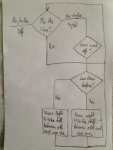Dear all,
Here is a little video I shot today if how my line follower behaves. It basically manages a few corrections in the right direction, progressively overshooting until it cannot return anymore. The steering seems fast, powerful and precise, when I disconnect the line following code.
I have tried different proportional coefficients (PID) - multipliers for the error and I basically get the same sort of error. I could now go and try to add the I component (PID), but if I understand the theory correctly, it is unlikely to help. I should be able to navigate the line anyway, albeit oscillating. Or am I wrong?
Has anyone seen a line follower act like this and knows the cause and solution?
Thank you for your input,
Edmunds
Here is a little video I shot today if how my line follower behaves. It basically manages a few corrections in the right direction, progressively overshooting until it cannot return anymore. The steering seems fast, powerful and precise, when I disconnect the line following code.
I have tried different proportional coefficients (PID) - multipliers for the error and I basically get the same sort of error. I could now go and try to add the I component (PID), but if I understand the theory correctly, it is unlikely to help. I should be able to navigate the line anyway, albeit oscillating. Or am I wrong?
Has anyone seen a line follower act like this and knows the cause and solution?
Thank you for your input,
Edmunds

